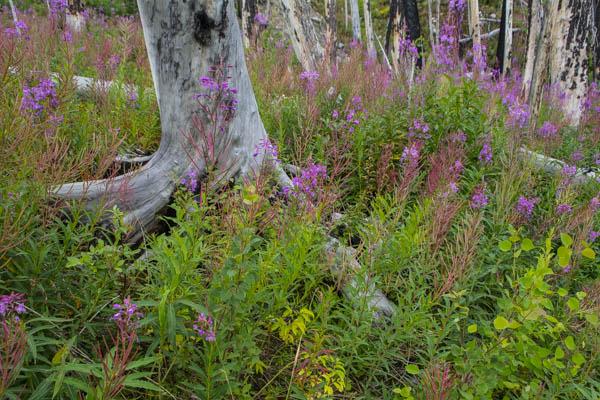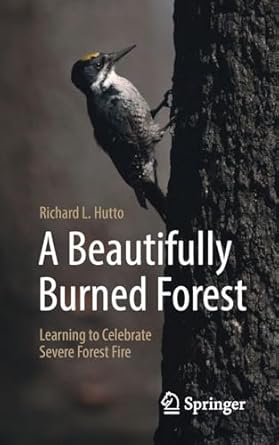


































































Fireweed in burnt forest, Absaroka-Beartooth Wilderness, Montana. Photo: George Wuerthner.
I attended the University of Montana as an undergraduate back in the 1970s. I had many professors who I felt were exceptional. The common denominator in the teachings of all my professors was to look at things from an ecological and evolutionary perspective.
Of all my professors, Richard (Dick) Hutto had the greatest influence on my thinking about ecology.
I took ornithology and several other ecology courses from Hutto. His enthusiastic lectures on evolutionary biology often ended with a smile and his signature exclamation, “Isn’t this cool?”
Yes, it was cool.
A good professor provides a new way to view the world. From Hutto, I learned to see things from an evolutionary perspective and to question traditional assumptions about ecology.
I was already beginning to confront my original assumptions about fire ecology and how the only “good fires” were low-severity and frequent, when the 1988 Yellowstone Fires occurred. At that time, I was residing in Livingston, Montana, just north of the park, and almost every day that summer, I was in the park observing the fires.

In part due to the worldview I gained from Dick’s classes, I have come to understand that many animals and plants live in mortal fear of green forests—they are so dependent on the dead snag forests and downed wood that results from these high-severity blazes, where most trees are killed.
Challenging traditional wildfire assumptions is central in Richard Hutto’s new book, A Beautifully Burned Forest: Learning to Celebrate Severe Fire. He’s among the few who study the unique, necessary role of severely burned forests in western conifer ecosystems. Hutto explains why negative views of burnt forests are misplaced, arguing for a new paradigm that values them as critical ecological elements and calls out misguided policies like post-fire logging and thinning.
His book, like his classes, is a superb overview of ecology and ecological thinking using wildfire to illustrate how to “think” about natural processes.
However, his book is more than a scientific thesis on wildfire. He tells his story in a first-person narrative, explaining how many experiences from growing up in southern California, with its frequent chaparral blazes, to his wide-ranging research specifically on birds from Mexico to the Northern Rockies influenced his thinking and understanding of wildfire.
Through the stories related in his personal narrative, we gain a great deal of insight into fire ecology.
Hutto’s insights into burnt forest were initiated by the Black-backed Woodpecker, a species almost entirely dependent on the snag forests resulting from high-severity fires. Like the sage grouse’s association with sagebrush, the Black-backed Woodpecker relies on an ephemeral ecological habitat—the severely burnt forest.
That a species could become dependent on such ephemeral habitat demonstrates that severe burnt forests were not some aberrations, but common enough that the woodpecker evolved to depend on these kinds of environments.
What his ongoing research demonstrated is that numerous species reach their greatest abundance in post-fire forests. Not only woodpeckers, but bluebirds, tree swallows, Townsend Solitaires, and Robins, among others.
Another discussion in Hutto’s book is the problems created by the use of fire scars to generalize about fire regimes or what Hutto calls the “forests are out of whack” narrative. I’ve discussed these problems in past commentary, though Hutto does a much better job of explaining how the use of fire scars skews our thinking. It’s worth the price of the book to understand the issue, since fire scars are almost universally used to determine the “historic” fire regime and management designed to “restore” or “fix” forests, usually through logging, but are full of methodological problems that distort interpretation. Most western forests naturally experience major wildfires only every few decades to centuries, so they do not require intervention or restoration.
Hutto suggests we must get over the idea that succession or plant and animal communities move towards some predetermined “climax” condition. In many ecosystems, the transitional stages are as critically important to the diversity of life as some “end state.”
Hutto laments that the story of the “beautifully burned forest” is a hard sell to the public since far too many agencies, companies, and even conservation organizations depend on promoting the idea that green forests are the ideal, and anything that threatens trees, from bark beetles to wildfire, is undesirable. We are inundated with the “good fire” (low severity) and “bad fire” that kills individual trees. However, this is a failure to see the forest through the trees.
The forest ecosystem depends on the occasional death of its trees (and associated shrubs). As Hutto rightly observes:
…we need to stop inundating the public with warlike language when it comes to severe fire and with images that play on a ‘good fire/bad fire’ theme designed to spread the falsehood that any burned-forest condition other than one following thinning and prescribed burning is undesirable.
Hutto observes that:
Despite the explosion of interest in forest fires these days, there is still surprisingly little ecology associated with the fire science literature. Instead, fire scientists are focused on understanding fire behavior so we can better control that behavior, primarily through timber harvesting and prescribed burning. Simply put, fire scientists undervalue ecology in their studies of fire.
Because of the natural public aversion to blackened forests, agencies promote policies like thinning (read logging) and prescribed burns to reduce (they claim) the occurrence of high-severity blazes. But as Hutto goes to great lengths to explain, these management strategies are not ecological analogues to natural high-severity wildfire. Logging removes the physical structure (potential snags and downed wood) common in severely burnt forests. He also notes, as I have, that the idea that Indian burning shaped most western ecosystems ignores the fact that such fires were primarily local, thus not a major ecological force across the western ecosystems.
Hutto articulates why these policies fail. Most high-severity wildfire events occur during extreme fire weather events—and under such conditions. As he suggests: “fuels play a trivial role under extreme weather conditions, which is when fires tend to burn severely across 98% of forested lands that do burn in the West, thinned or not.” And he argues, as others have said, that the way to protect homes and communities is to reduce the flammability of the home and surroundings.
He also challenges the idea that fire suppression prevents large blazes. In particular, he holds back nothing when he critiques post fire logging: “I am hard-pressed to find any other example in wildlife biology where the effect of a particular land-use activity is as close to 100% negative as the typical post fire salvage-logging operation tends to be.”
I recall skiing up Specimen Ridge in Yellowstone the winter after the 88 fires and seeing the gray snags left after the blazes against the snow, creating a beautiful black and white image and thinking to myself, “Why, this looks just like a New England winter forest scene.
Hutto asks us to see the burnt forest through new eyes. “With ecological education, the public can come to view a newly blackened hillside not as a scar, but as a beauty mark on the landscape!”
I think it would be difficult after reading Hutto’s book to see the burnt forest landscape as anything but wonderous and beautiful.
The Beautifully Burned Forest is a book that I wish I could get into the hands (and, of course, hope they read it) of every politician, agency land manager, and conservation organizations. It will surely make you exclaim as Hutto did every day in class—”Isn’t this cool!”
The post Finding Beauty in a Burnt Forest: Toward a Paradigm Shift on Wildfire appeared first on CounterPunch.org.
This post was originally published on CounterPunch.org.